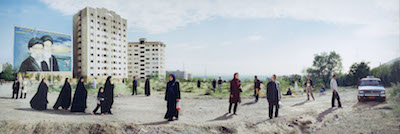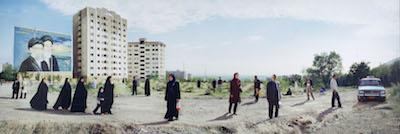Born in Tehran, Mitra Tabrizian lives and works in London, where she has successfully pursued a threefold career as an academic (she is professor of photography at the University of Westminster), a filmmaker, and a photographer. She has published and exhibited widely in major international museums and galleries, including her 2008 solo exhibition at the Tate Britain, where Tehran 2006 was the signature work.
 Mitra Tabizian, Tehran 2006, 2006, gift of the Buddy Taub Foundation, Jill and Dennis A. Roach, Directors, through the 2014 Collectors Committee, © Mitra Tabrizian, courtesy Leila Heller Gallery, New York, photo © 2014 Museum Associates, LACMA
Mitra Tabizian, Tehran 2006, 2006, gift of the Buddy Taub Foundation, Jill and Dennis A. Roach, Directors, through the 2014 Collectors Committee, © Mitra Tabrizian, courtesy Leila Heller Gallery, New York, photo © 2014 Museum Associates, LACMA
Tabrizian is best known for her photographs in which the subject matter is both “Western” and Iranian, addressing a broad range of topics but especially exile and alienation as displayed through staged and often disturbing human tableaux. The monumental Tehran 2006, a metaphorical study of isolation, displacement, and social upheaval, is perhaps the most masterful of her works. Although Tabrizian views film and photography as two separate media, her fascination with contemporary Iranian cinema bleeds into photographs like this one, where she employed ordinary people who played themselves (as in some of Abbas Kiarostami’s greatest work), and whom she directed in their placement, attitude, and movement. The scene was photographed much like a wide-angle shot in a film, resulting in a panoramic view but without resorting to digital stitching. Tehran 2006 was photographed in a then-recently developed residential section in the northwestern area of Tehran. In the setting, the artist deliberately evokes a society without a functioning infrastructure: there are no street lights—or, for that matter, streets. Even the omnipresent billboard, with its iconic images of Iran’s revolutionary leaders—Khomeini and the current Supreme Leader Khamenei—seem incapable of imposing order or direction. Juxtaposed against the directionless inhabitants pictured in the foreground, the billboard’s main text suggests an intentional irony: “We will continue [on] the path of the imam and martyrs of the Revolution.”
LACMA first began to acquire contemporary art of the Middle East within the context of our Islamic collection in 2006. Today, we have the largest body of such works in the United States, which provides us with an important means to build creative links between the past, present, and future. Mitra Tabrizian’s Tehran 2006 is the latest wonderful addition to this growing collection. The photograph will be included in a special exhibition of works from LACMA’s contemporary Middle East art collection, scheduled for early 2015.
Linda Komaroff, Curator, Islamic Art, and Department Head, Art of the Middle East



